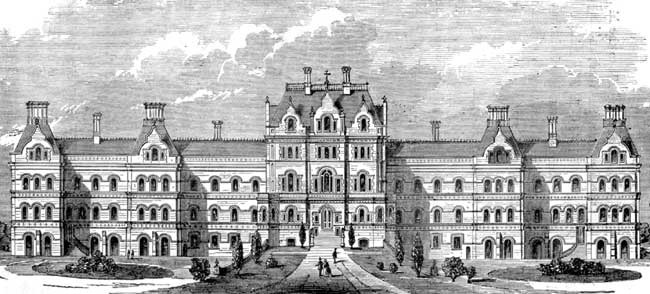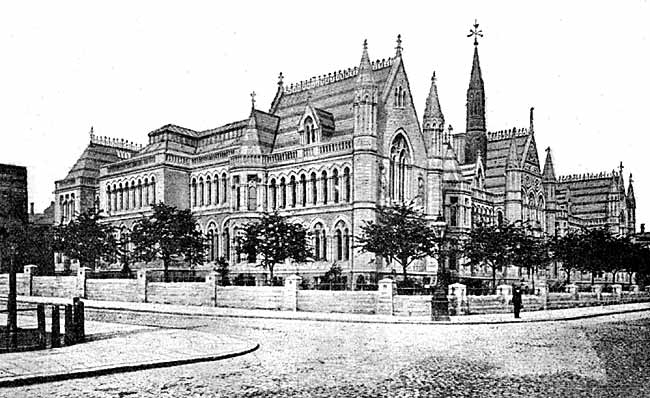On coming into the road—North Sherwood-street-visitors should walk to the top of it, and the Church Cemetery will be reached. This is thirteen acres in extent. Down the right-hand path there is a remarkable series of caverns, scooped out of the living rock. These caverns are exceedingly well adapted for catacombs and interments, and if the original plan be carried out, the Cemetery will, as a whole, perhaps stand unsurpassed in the kingdom. The tombs and monuments, which are numerous, present' most beautiful specimens of the sculptor's art. This Cemetery is well laid out, and is neatly kept. Viewing the north-west part of the country beyond the Cemetery, a diversity in the landscape is presented which the eye marvels at, and which the pen can but inadequately describe. In the centre are the populous manufacturing districts of Old Radford, Hyson Green, New Basford, and Carrington, now all absorbed into the Borough, whilst in the distance, to the left, is Wollaton Hall and Park, the former one of the most perfect specimens of English domestic architecture in the country. To the north may be descried a beautiful mansion, Bestwood Lodge, the seat of His Grace the Duke of St. Albans. As it were in a deep valley, is the picturesque Race-course and cricket Grounds, rendered more beautiful by a number of well arranged and profusely planted public walks. This race-course, lying in a valley, is one of the most prettily situated courses in the United Kingdom and spectators can see the whole of it, which is a mile and a quarter in circumference. Races are held here in spring and in autumn. The Grand Stand, near the centre, is not an elegant structure. The broad road skirting "the Forest" (as this locality is designated) is "the Gregory Boulevard," and is part of a belt round the commercial portion of the town.
A penny tram ride carries passengers nearly the length of Forest-road, starting from and to the Cemetery gates. This road runs along one side of the church Cemetery, and is a residential district. A little distance beyond the Cemetery, and on the same side of the road, is a brick structure of Gothic design—" the-Congregational Institute "—an Independent College for the training of about fifty students, who are non-resident. It was erected about 1867. On the left-hand side, partly hidden by a lofty stone wall, is the rear of "the High School" for boys.
Beyond the Race-course, and opposite the end of the Boulevard and the Police Station, is the Forest House; and just beyond, on the right-hand of the road, at the corner of Redcliffe-road, in Carrington, is an United Methodist Chapel, of neat design, and with a small tower and spire. A little distance beyond, opposite Mapperley Park and Hall, is the tram terminus, from which the journey to the Market-place may be made (fare 2d.)
Opposite the Cemetery gates is St. Andrew's Church—a striking landmark. Proceeding along the south side of this sacred edifice—Mapperley-road—past a number of superior residences, visitors will shortly arrive at St. Ann's Hill, or Belle Vue Reservoir, one of the principal water supplies for the town, where a panoramic view of marvellous extent is obtained, embracing much of the town of Nottingham, the valley of the Trent, with Belvoir Castle and Leicestershire Hills in the distance. It is approached by 'a flight of steps on the right hand of the road. On the opposite side of the reservoir (around which is a walk) are two avenues—the Corporation Oaks, and Elm Avenue.
Passing down the latter slope, visitors will emerge into Mansfield-road (a very broad highway, which is lined with trees—the first tree being planted December 9, 1863). Here they may meet with a passing tram-car going down the hill to the Market-place (fare 2d.) A short distance down the road, at the junction of live roads, on the right-hand side, is The Blue Coat School, designed in the Elizabethan style, standing in its own grounds, and opened in 1853. Sixty boys and twenty girls are educated here, by the funds bequeathed in 1706.

"THE COPPICE" LUNATIC ASYLUM.
Opposite this is Woodborough-road. Nearly opposite the Blue Coat School, at the angle of two roads, is a Wesleyan Methodist Chapel, of original design, in brick, with stone dressings. The huge unpretentious building to the right is the Nottingham Union Workhouse, and the turret to the left of that surmounts one of the Board Schools—the Huntingdon-street Board School, a neat brick building, in the first street to the left. On the hill side is an unfinished and well-attended stone church of excellent design—Emmanuel Church. A little beyond are approaches to "The Corporation Oaks" (see page 30), and its continuation, "Robin Hood's Chase." A little further on may be seen (on the right hand, looking down Sycamore-road), some of the garden allotments, by which Nottingham is famous; and further on is a Water-pumping Station. Close by, and distant from the Market-place about two miles, is the Borough Asylum; and beautifully situated on an eminence, which commands an extensive view of the surrounding country, is The Coppice Lunatic Asylum for private patients only. It was built by private subscription, at a cost of £20,000, from the designs of Mr. T. C. Hine, F.S.A., and is 270 feet in length. Of this building we give an illustration on the following page. Visitors are now in the immediate locality of allotment gardens, close to the Robin Hood Rifle Butts, and only a short walk from 'buses which convey passengers (for 2d. from the “Westminster Abbey”) to Nottingham Market-place. This detour will occupy about two hours (or more) of the time of visitors. The route laid down in this Guide may, however, be followed, if visitors alight from the 'bus in St. John's-street. Passing the Police and Fire Stations, Her Majesty's Prison, and turning up the main road (Milton-street) to the right, visitors will pass Trinity Church, the Mechanics' Institution, and at the corner of the next street (on the same side), Morley House—a brick and stone building—will be reached.
The next building on the main road of any note is on the right, and is known as The Tabernacle (formerly Exeter Hall), and is a Baptist Chapel, with a horse-shoe plan for the tabernacle proper. In the side street is The Cobden Club, a popular Liberal Club.
Adjoining the Tabernacle is a brick building, with stone dressings, called Morley House, with its cafe; Morley Club, which is worked on total abstinence lines, with abstaining and non-abstaining members; offices for the Band of Hope Union; Building societies and money clubs; and rooms for Good Templar, Odd-fellow, and Rechabite meetings. Next door, round the corner, and in Shakespeare-street, is the Christadelphian Hall, a brick erection of unusual style, used as a place of religious meeting by the Christadelphians. Opposite is the Board School for deaf and dumb mutes, a building which is commonly known as "the Coffin Chapel," from its plan. A little further on, and on the right-hand side of the road, is the Children's Free Public Lending Library and Reading Room of three-thousand carefully-chosen volumes— the gift of the late Mr. Samuel Morley, M.P. It is open from 4 to 8 on week-days. Immediately opposite are the Firemen's Cottages, in close proximity to the new Fire Brigade Station— part of the new Guild Hall buildings, about which more anon.
[Visitors who did not visit the Catholic Cathedral, General Cemetery, &c., should follow the tram lines past the Mechanics' Institution, Trinity Church, the Express Office, down Market-street into the Market-place, and continue the route laid down in the Guide on page 40.]

UNIVERSITY COLLEGE AND FREE PUBLIC LIBRARY.
The University College buildings, with their surrounding grounds, occupy the whole of a plot of land in South Sherwood, Shakespeare, and Bilbie-streets, which was until recently known as "The Horse-fair Close," having been used for that purpose for a long period. It is the finest pile of public buildings in Nottinghamshire: is Gothic in design, and is built of Ancaster stone. This fine range was erected by the Corporation of Nottingham at a cost of about £75,000. These buildings have three facades, as already suggested, the principal of which is in Shakespeare-street. This frontage, and a centre block behind, is the University College proper. It consists of three lecture theatres, examination and class rooms; chemical, physical, and biological laboratories; professors' and committee rooms, offices, &c. In this building Students are educated for University careers and degrees, under the direction and tuition of a Principal and Board of Professors, assisted by an efficient staff of demonstrators, lecturers, and teachers, with every modern appliance. The Government Science Classes are also held here, and are taught by very efficient teachers. The curriculum is a broad one. The College is attended by about fifteen hundred non-resident students, some of whom have taken up their residence in Nottingham in order to avail themselves of the many educational advantages which are offered by the College authorities. A Committee of the Corporation, with representatives of the old Universities, and a few other "outsiders," manage the affairs of the College. The building is not accessible to the general public during term time, but no objection is offered to visitors inspecting the entrance hall and, possibly, one of the lecture theatres.
